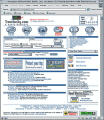Travelocity.com: A Glimpse Through History
 To round up the year 2003, Internet Travel News takes a retrospective look at the history behind the world’s second largest online travel site, Travelocity.com. Marty Gast, an online marketing consultant, and former VP of Segment Marketing for Travelocity.com reflects and tells his story of the launch of Travelocity.
To round up the year 2003, Internet Travel News takes a retrospective look at the history behind the world’s second largest online travel site, Travelocity.com. Marty Gast, an online marketing consultant, and former VP of Segment Marketing for Travelocity.com reflects and tells his story of the launch of Travelocity.
In The Beginning
Travelocity was launched on March 12, 1996 by Sabre Interactive, a division of AMR Corporation, which at the time owned the Sabre Reservations System and American Airlines.
Funded as a Sabre development project, the technology team that built Travelocity came from Sabre. While the original launch team was relatively small (around 30 people), we had access to dozens of developers, consultants and other Sabre employees.
 Terrell B. (Terry) Jones, the Chief Information Officer at Sabre, was put in charge of developing the online booking system that would eventually become Travelocity.com.
Terrell B. (Terry) Jones, the Chief Information Officer at Sabre, was put in charge of developing the online booking system that would eventually become Travelocity.com.
Unfortunately, at the start date, most people at Sabre regarded Travelocity as a research and development effort to test new technology and during the first year of Travelocity’s development, it was very difficult to persuade people from other Sabre divisions to come work on Travelocity. Many felt that it was not a good career move, and that Travelocity would never replace Sabre’s primary business - the “travel agent.”
ADVERTISEMENT
But the Travelocity team was not without online travel experience. By the time Travelocity launched, Sabre had almost 10 years of “online travel reservation” experience with the first online travel reservations system, called “easySABRE”.
This tool allowed consumers to make reservations on American Airlines through their early modems.
Whilst the Internet was just starting to gain popularity during the development of Travelocity, Terry Jones knew that once people experienced online booking, they would become hooked.
Most of those who chose to leave their secure “traditional travel” careers and come to work for Travelocity believed that the future of travel reservations would move online. What we didn’t know then was just how huge it would be.
The Design
The original Travelocity homepage design was the result of a collaboration between the Travelocity marketing and development team and Meyer and Johnson advertising agency. The design plan to launch was that the Travelocity homepage would consist of four large buttons - an “Air Reservations” button (no hotel or car reservations we available for launch); plus (through a partnership with Worldview Systems) Destination information, Chats and Forums, and Merchandise Mall.
In the few weeks prior to launch, the marketing and sales team convinced management to add some marketing text next to each of the buttons - and to add two ad banners at the bottom of the page. Selling advertising was something foreign to Sabre and the prevalent thinking was - “A travel site should sell travel, not advertising.” Fortunately, advertising sales were allowed, and eventually grew to become 25% of net revenues.
During the early years, Terry Jones would always tell us that Travelocity’s biggest competitor was - the telephone. People were in the habit of calling a travel agent or supplier to make a travel reservation - and habits are sometimes hard to break. Internet unfamiliarity and security were also big issues, and to some extent, continue to be big issues today.
There were a few other competing travel websites at this time, although many of these have long since vanished (PC Travel, Preview Travel, Worldview Systems).
By 1999, Travelocity’s lead as the top online travel website was nearing its fourth consecutive year - but Expedia was gaining fast. In October 1999, Travelocity announced it would merge with Preview Travel (the third largest online travel site), giving Travelocity access to all of Preview Travel’s customers. The combined audiences allowed Travelocity to stay ahead of Expedia for another year. By April 2001, Travelocity celebrated five years of online travel leadership - and its first profitable quarter.
“On April 3 (2001) we celebrated Travelocity’s fifth birthday, which marks a major milestone for an Internet company,” commented Terrell B. Jones, president and chief executive officer of Travelocity. “During those years, we have been consistent in building and executing our successful business model. We have continually introduced new features and innovations that keep Travelocity in a leadership position, and we have been disciplined in accomplishing our operating goals time and again. Our results [the first profitable quarter] prove that the concept of booking travel on the Internet works.”
 Today
Today
The main difference in Travelocity over the past eight years is the volume of products and services offered. When Travelocity launched, the only thing you could do was make an airline reservation and look up some destination information. Today, there’s not much you can’t do - air, hotel, car, cruise, vacation packages, flight information - anything related to travel can be found somewhere on Travelocity.
Travelocity has evolved in much the same manner as most online ecommerce websites - a lot of it was through product innovation, some came from customer feedback, and recent evolution has been through competitive pressure. Ultimately it comes down to survival of the fittest - the products and services that meet customer needs get added to the site, those that don’t get dropped.
I think Travelocity is at a similar stage of evolution as Microsoft’s Windows operating system. They need to stop developing new products and services and focus on making the ones they have more reliable and easier to use.
Loyalty Programmes
Charging someone to join a “loyalty program” is one of the worst ideas to come out of Internet intermediary travel sites. Smart suppliers will eventually own the customers. Any loyalty to intermediaries will come from spending millions on brand marketing, delivering excellent service and product offerings and consistently good customer service. But in the end, customers will continue to shop for the best deal - and the best you can hope for is that you’re always on their shopping list.
Looking Ahead
Whilst predictions always come back to haunt you, if I believe 2004 will be a turnaround year for Travelocity, starting with dramatic changes to the website and the way they conduct their business. Orbitz
will continue to be a major challenger for the number 2 spot. And, while I think it will be very difficult to regain their former momentum, they should make great strides under the leadership of Michelle Peluso.
 Michelle’s appointment as CEO this year was the best move Sabre could have made. Michelle will make a great leader for Travelocity. She has business savvy and an entrepreneurial spirit—exactly what Travelocity needs. She has the respect of the entire Travelocity team and has surrounded herself with a lot of smart people. If she can balance the needs of Travelocity within the needs of Sabre, she’ll be the next CEO superstar.
Michelle’s appointment as CEO this year was the best move Sabre could have made. Michelle will make a great leader for Travelocity. She has business savvy and an entrepreneurial spirit—exactly what Travelocity needs. She has the respect of the entire Travelocity team and has surrounded herself with a lot of smart people. If she can balance the needs of Travelocity within the needs of Sabre, she’ll be the next CEO superstar.
Highs And Lows
Launching Travelocity was the best experience of my life. Anyone who has been a part of a successful website launch knows the feeling of accomplishment and pride that come from seeing your “baby” take its first steps. Even today, as I look at Travelocity, I see design elements or products that I personally had a hand in bringing to market.
The low point for me would be in late 2001. Expedia
had just taken the number 1 travel spot, the economy was getting bad, and the events of September 11 sent the travel industry into a tailspin. Travelocity reacted by downsizing several hundred people, many of whom had been with the site since it launched. It seemed as though the momentum had just stopped, and everyone in the travel industry was wondering “what’s next?”
Online Consolidation
The online travel industry has many parallels the television industry in the United States and I believe it will continue to follow the same changes. When television began, there were a few major networks and a lot of local stations. For several decades the three major television networks held their dominance, while local stations filled the need for “niche market” information. Then cable television exploded and brought programming from some of these small local stations into the national attention. Soon small networks, like FOX, started challenging the three major networks for a piece of the audience. Consumers liked having more choices and soon cable-only programming like HBO started taking viewers away from the major networks.
So, what does this mean for the future of the online travel market? I think we’ll see the three major online travel sites continue their dominance, but the public wants choices and the major travel sites cannot efficiently cater to everyone’s needs and still be profitable. That’s where niche travel sites will do well. As long as there are websites that specialize in niche travel - like golf packages or extreme scuba diving - they will cater to the needs of that audience much better than a general travel “super-site”. A few years from now, the online travel space will look a lot like cable television - a few major players, plus a lot of niche services.
——-

